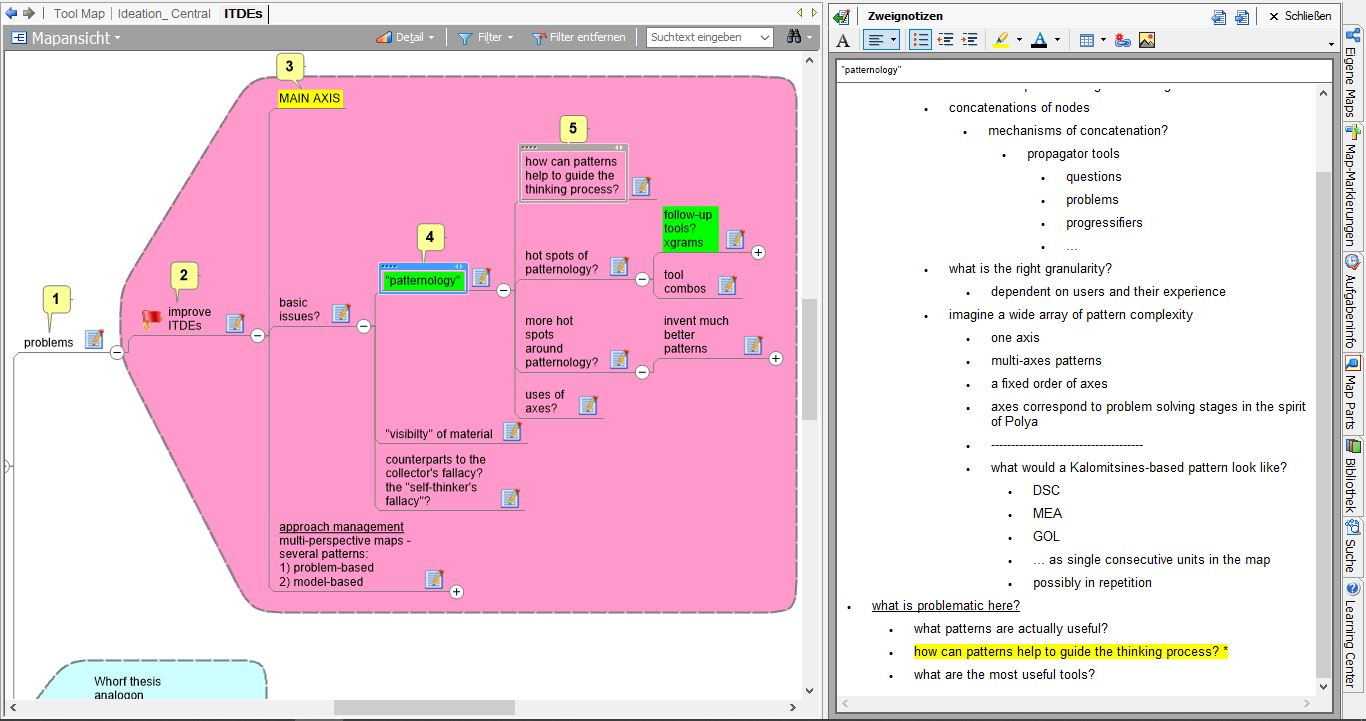Folgezettel emerging from questions
In his blog post "Understanding Hierarchy by Translating Folgezettel and Structure Zettel", Sascha asked the following
"Question for the community
1. If you use the Folgezettel technique, what are your actual goals?
2. How do you measure your progress towards those goals?"
In my use of elements from zettelkasten practice, folgezettels mainly emerge from a parent through questions or goals or seminal ideas that look promising.
The following screenshot (from the mind mapping software I use) may help to show the basic idea.

With reference to the numbers in yellow:
- In node 1, I collected basic problems I found in my topic (again, it's "Integrated Thought Development Environments").
- In node 2 I have chosen a problem aspect that seemed particularly interesting to me.
Node 3 is just a headline "Main Axis" - this axis is formed by its sibling nodes.
What I find fairly compelling about this axis concept is that it is easy to come back to it and see what else should be done about the problem given in node 2.Node 4 has emerged from its parent, where I hit upon the concept of "patternology", a "theory of patterns" and how they could be used to give structure to a thinking process.
The textnotes to this node 4 are shown in the right hand side of the screenshot. At the end of these textnotes, I collect questions about the ideas found so far.The question "how can patterns help to guide the thinking process?" leads to the next node 5.
- The child nodes to node 4 form another "axis" where I can add nodes until I'm satisfied with
Obviously, the ideas generated by this progress need consolidation and reorganizing - the node hierarchy shown above is not a good starting point to resume your thinking months or years later. - It seems a good idea to write a crisp summary.
I do not suggest that an entire zettelkasten could work on the principles illustrated above. But I find it helpful for thinking about problems.
(Remark: I did not directly comment on Sascha's blog post because I was not sure how to embed the screenshot.)
Howdy, Stranger!

Comments
Mh. It does look a bit hierarchical to me, or am I wrong? (not a critique!)
I am a Zettler
@Sascha - yes, it is "a bit hierarchical".
Here are some thoughts.
First, I started using mind mapping software in the previous millennium.
So what follows are some hindsight constructions to justify that ;-)
For the purpose of problem solving, I find a _graphical _ structure of "note units" very helpful.
Here are some features I like:
I am sceptical whether software that provides more flexible graphical overviews would have an extra benefit for me - for me, the reduction to a tree structure helps with keeping things straightforward.
My experiences with such software are however very limited.
There is no question that the branches that grow from the process outlined above are not an optimal summary of the ideas and insights generated.
I think about that for years (gawd..). There are disciplines who benefit from an extended working memory. Version 2 of The Archive will expand on that thought. I think that with mathematics (I recall it right that you're mathematician?) it is especially true and I assume for physics, too. Chalk boards are a thing.
I use incremental versions of drawings for that purpose if I really need to juggle many items in my head over many sessions.
I am a Zettler
@Sascha - well said, "chalk boards are a thing".
Here is a collection of photos of blackboards.
I share this not only for its (sometimes a bit ostentatious) beauty. The photos remind me of the power of non-text representations, like diagrams and formulae. I suspect that when people developed some of the finest ideas in history they made heavy use of these. - For me, it's a memento not to rely overly on digital text-only tools.
Some days ago, I asked the project coordinator of the Luhmann archive to what extent Luhmann used diagrams on his zettels.
Here are two examples, which Luhmann took basically from the literature:
https://niklas-luhmann-archiv.de/bestand/zettelkasten/zettel/ZK_1_NB_28-10l5c3d5gc_V
https://niklas-luhmann-archiv.de/bestand/zettelkasten/zettel/ZK_1_NB_28-10l5c3d5e_R.
Yes. Integration of drawing and text is already in The Archive for that reason. I quite often make a drawing, number the important elements for reference and comment on it:
(For the non-Germans: This is an extention of the flow-model by Csikszentmihalyi)
I am a Zettler
After Ann-Laure's post on digital gardens with Tiddlywiki I made some experiments with Tiddlywiki.
The result is yet another demo how zettelkästen can be used for problem solving, where the hierarchical view on the problem solving process is flexibly combined with non-hierarchical linking between notes.
More at thomasteepe-archiv.de/.
(I've tried to keep it self-contained - the core parts are those on various structure maps and on tools.)